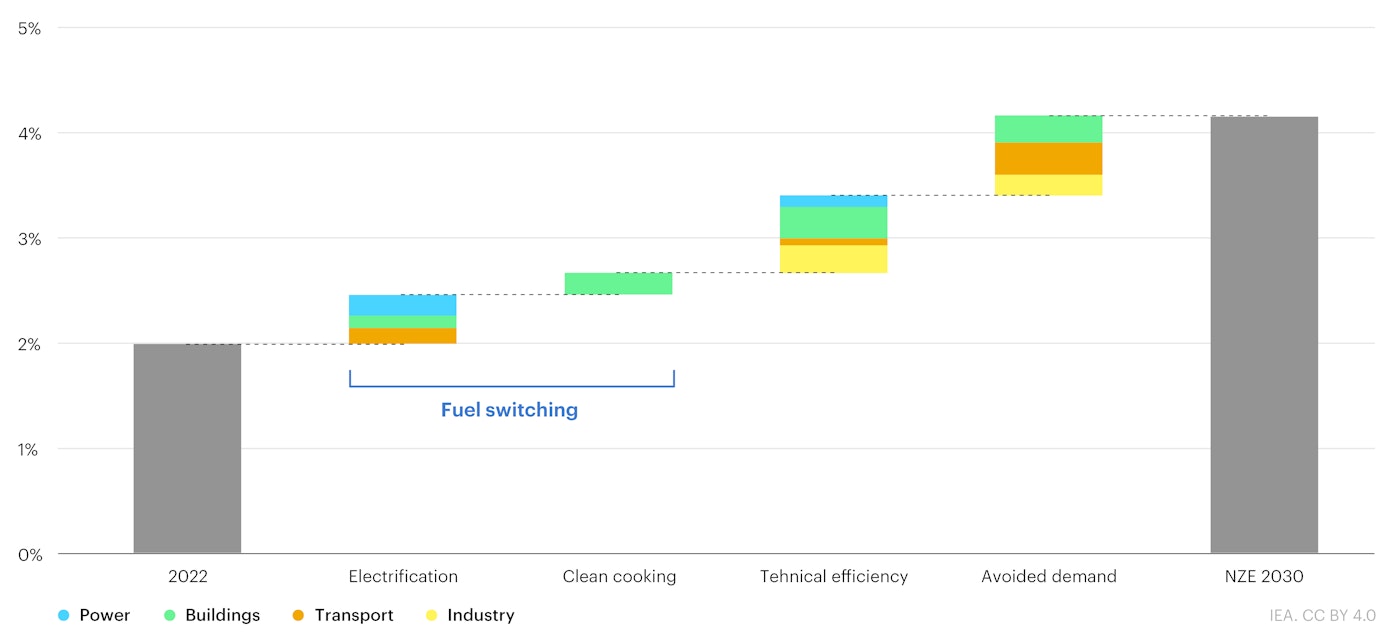Cite report
IEA (2023), Net Zero Roadmap: A Global Pathway to Keep the 1.5 °C Goal in Reach, IEA, Paris /reports/net-zero-roadmap-a-global-pathway-to-keep-the-15-0c-goal-in-reach, Licence: CC BY 4.0
Report options
Making the Net Zero Scenario a reality
- Increasing renewables capacity threefold is the single largest driver of emissions reductions to 2030 in the Net Zero Emissions by 2050 Scenario (NZE Scenario). Advanced economies and China are projected to reach around 85% of the required renewables capacity by 2030 with current policies; more robust policies and international support are needed in other developing countries.
Installed renewables capacity by technology in emerging market and developing economies excluding China in the Stated Policies and Net Zero Scenarios, 2022-2030
OpenInstalled renewables capacity by technology in advanced economies and China in the Stated Policies and Net Zero Scenarios, 2022-2030
Open- Doubling the rate of energy intensity improvements makes a critical contribution to emissions reductions to 2030 and also bolsters energy affordability and security. This is achieved in the NZE Scenario by efficiency gains from fuel switching to electricity, improvements in technical efficiency, and the more efficient use of materials and energy including through behavioural change.
Rate of annual primary energy intensity improvements by lever in the NZE Scenario
Open
- Further electrification of end-uses makes the third largest contribution to emissions reductions by 2030. The current growth rate of electric cars sales would be sufficient to meet the 2030 level of deployment envisaged in the NZE Scenario, although faster uptake is needed in trucks. Installations of heat pumps need to expand by almost 20% per year to 2030, compared with 11% in 2022.
- Cutting energy sector methane emissions also brings huge climate benefits. In the NZE Scenario, around USD 75 billion in cumulative spending is required to 2030 to deploy all methane abatement measures in the oil and gas sector. This is equivalent to just 2% of the net income received by the oil and gas industry in 2022.
- Emerging technologies such as hydrogen and carbon capture, utilisation and storage (CCUS) cut emissions mainly after 2030. If all announced projects for hydrogen electrolysis capacity are realised, they would provide around 70% of what is required in the NZE Scenario by 2030. Announced CCUS projects, currently mostly in advanced economies, would provide nearly 40% of what is needed by 2030 globally. A stronger policy focus on creating demand for low-emissions products and fuels is needed.
Global hydrogen demand in the Net Zero Scenario, 2022-2050
Open- A net zero emissions energy system requires more and varied infrastructure. Transmission and distribution grids expand by around 2 million km each year to 2030, and around 30 000 to 50 000 km of CO2 pipelines need to be installed in the NZE Scenario. New hydrogen infrastructure is also necessary. Delivering the needed infrastructure depends in part on expediting planning and permitting processes.
- If policy ambition is not increased before 2030, limiting the increase in global average temperature to 1.5 °C by 2100 will become much harder. Much more CO2 would need to be removed from the atmosphere after 2050. The Delayed Action Case indicates that postponing stronger action would cost the world an additional USD 1.3 trillion per year, 50% more than was invested in fossil fuel supply in 2022.